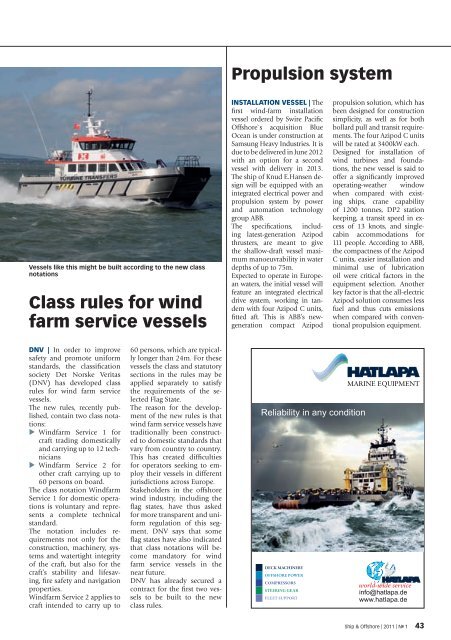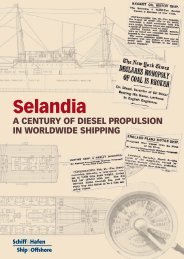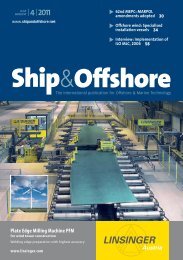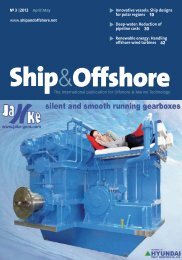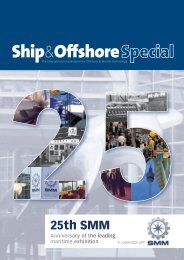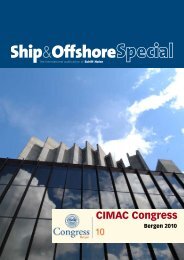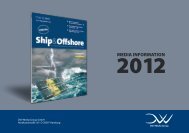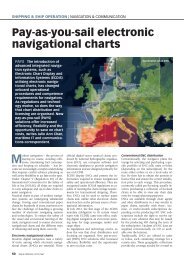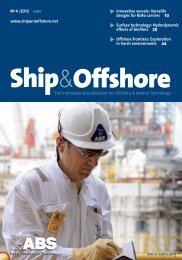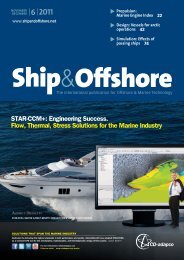Arctic technology: Winterisation of FPSO 38 Cruise ... - Ship & Offshore
Arctic technology: Winterisation of FPSO 38 Cruise ... - Ship & Offshore
Arctic technology: Winterisation of FPSO 38 Cruise ... - Ship & Offshore
Create successful ePaper yourself
Turn your PDF publications into a flip-book with our unique Google optimized e-Paper software.
Vessels like this might be built according to the new class<br />
notations<br />
Class rules for wind<br />
farm service vessels<br />
DNV | In order to improve<br />
safety and promote uniform<br />
standards, the classifi cation<br />
society Det Norske Veritas<br />
(DNV) has developed class<br />
rules for wind farm service<br />
vessels.<br />
The new rules, recently published,<br />
contain two class notations:<br />
�<br />
�<br />
Windfarm Service 1 for<br />
craft trading domestically<br />
and carrying up to 12 technicians<br />
Windfarm Service 2 for<br />
other craft carrying up to<br />
60 persons on board.<br />
The class notation Windfarm<br />
Service 1 for domestic operations<br />
is voluntary and represents<br />
a complete technical<br />
standard.<br />
The notation includes requirements<br />
not only for the<br />
construction, machinery, systems<br />
and watertight integrity<br />
<strong>of</strong> the craft, but also for the<br />
craft’s stability and lifesaving,<br />
fi re safety and navigation<br />
properties.<br />
Windfarm Service 2 applies to<br />
craft intended to carry up to<br />
60 persons, which are typically<br />
longer than 24m. For these<br />
vessels the class and statutory<br />
sections in the rules may be<br />
applied separately to satisfy<br />
the requirements <strong>of</strong> the selected<br />
Flag State.<br />
The reason for the development<br />
<strong>of</strong> the new rules is that<br />
wind farm service vessels have<br />
traditionally been constructed<br />
to domestic standards that<br />
vary from country to country.<br />
This has created diffi culties<br />
for operators seeking to employ<br />
their vessels in different<br />
jurisdictions across Europe.<br />
Stakeholders in the <strong>of</strong>fshore<br />
wind industry, including the<br />
fl ag states, have thus asked<br />
for more transparent and uniform<br />
regulation <strong>of</strong> this segment.<br />
DNV says that some<br />
fl ag states have also indicated<br />
that class notations will become<br />
mandatory for wind<br />
farm service vessels in the<br />
near future.<br />
DNV has already secured a<br />
contract for the fi rst two vessels<br />
to be built to the new<br />
class rules.<br />
Propulsion system<br />
INSTALLATION VESSEL | The<br />
fi rst wind-farm installation<br />
vessel ordered by Swire Pacifi c<br />
<strong>Offshore</strong>`s acquisition Blue<br />
Ocean is under construction at<br />
Samsung Heavy Industries. It is<br />
due to be delivered in June 2012<br />
with an option for a second<br />
vessel with delivery in 2013.<br />
The ship <strong>of</strong> Knud E.Hansen design<br />
will be equipped with an<br />
integrated electrical power and<br />
propulsion system by power<br />
and automation <strong>technology</strong><br />
group ABB.<br />
The specifi cations, including<br />
latest-generation Azipod<br />
thrusters, are meant to give<br />
the shallow-draft vessel maximum<br />
manoeuvrability in water<br />
depths <strong>of</strong> up to 75m.<br />
Expected to operate in European<br />
waters, the initial vessel will<br />
feature an integrated electrical<br />
drive system, working in tandem<br />
with four Azipod C units,<br />
fi tted aft. This is ABB’s newgeneration<br />
compact Azipod<br />
����������������������������<br />
propulsion solution, which has<br />
been designed for construction<br />
simplicity, as well as for both<br />
bollard pull and transit requirements.<br />
The four Azipod C units<br />
will be rated at 3400kW each.<br />
Designed for installation <strong>of</strong><br />
wind turbines and foundations,<br />
the new vessel is said to<br />
<strong>of</strong>fer a signifi cantly improved<br />
operating-weather window<br />
when compared with existing<br />
ships, crane capability<br />
<strong>of</strong> 1200 tonnes, DP2 station<br />
keeping, a transit speed in excess<br />
<strong>of</strong> 13 knots, and singlecabin<br />
accommodations for<br />
111 people. According to ABB,<br />
the compactness <strong>of</strong> the Azipod<br />
C units, easier installation and<br />
minimal use <strong>of</strong> lubrication<br />
oil were critical factors in the<br />
equipment selection. Another<br />
key factor is that the all-electric<br />
Azipod solution consumes less<br />
fuel and thus cuts emissions<br />
when compared with conventional<br />
propulsion equipment.<br />
���������������<br />
��������������<br />
<strong>Ship</strong> & <strong>Offshore</strong> | 2011 | N o 1 43


